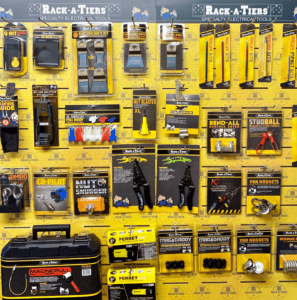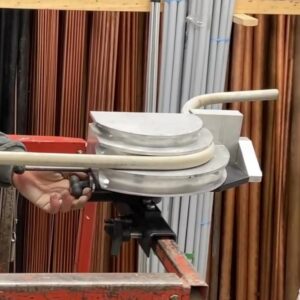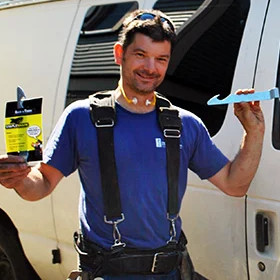How to Turn Your Electrical Tool Idea Into Reality: Tips From Ken MacLachlan
So, you’ve invented an electrical tool. Now what? If you have spent any time on a jobsite, you have probably seen a Rack-A-Tiers tool in action. What most people don’t know is that the company began in a friend’s garage with two pieces of plywood and a simple idea. In this interview, Ken MacLachlan talks about how Rack-A-Tiers got its start, what electricians should understand before pitching a new tool, and why some inventors break through while others stall out. Your tool idea could change the industry forever, so read on to find out how to get started!
How Rack-A-Tiers Got Its Start
 Rack-A-Tiers: The Rack-A-Tiers wire dispenser is an industry standard that everyone knows now, but how did it all start?
Rack-A-Tiers: The Rack-A-Tiers wire dispenser is an industry standard that everyone knows now, but how did it all start?
Ken: Well, it started with two pieces of plywood in my friend’s garage. I said maybe we can sell these. We were naive and young, and we never thought of plastic or anything. We just thought in our mind we could buy nice plywood, router them all up, dip them in varathane and sell them to make money. And realistically, that was impossible because of the cost of making them. The wooden ones sold very well, but we lost money on every one that sold.
We learned that quickly after making the first 30 that we couldn’t carry on that way. So we just said the only way we can make these is we gotta have a plastic mold. That’s when we went in that direction.
 Rack-A-Tiers: What gave you the motivation and confidence to turn that invention into a full business?
Rack-A-Tiers: What gave you the motivation and confidence to turn that invention into a full business?
Ken: I’ve just always been an entrepreneur. When I see something, I say oh can I make that successful? So, I saw the two pieces of plywood in my partner’s garage, and I said maybe we can sell these. There are people who just can’t be in business, right? You talk to them, and they say, oh I can’t be bothered. I just want to go to work and go home and watch TV. There are many people like that, and I was never one of them.
Get the Legendary Rack-A-Tiers Wire Dispenser
What Tool Inventors Need to Know
 Rack-A-Tiers: You receive a lot of submissions from electricians who have created a new tool. Is there something you wish they knew before sending in their invention idea?
Rack-A-Tiers: You receive a lot of submissions from electricians who have created a new tool. Is there something you wish they knew before sending in their invention idea?
Ken: Since 2022, we’ve had 900 inventors come to us, and we’ve had something like 20, maybe a bit more, that we end up developing. We get inventions, the new Pipe Site is one example, where some version comes to us, probably 30 times. So, the trouble is, every inventor thinks he’s got the million-dollar idea without really doing any research about it or testing and prototyping it themselves a bit.
If you take Wire Waffle, for example. The inventor did a lot of legwork. He made it, he got it approved and had a track record with sales. That’s the bottom line with an invention: you’re working with that less than five percent success rate, so the more work you do before pitching it, the better your odds.
Why Rack-A-Tiers is the Best Partner for Your Invention?
 Rack-A-Tiers: A lot of electricians have ideas for new tools or inventions, but don’t know what they should do with them. Why do you think working with Rack-A-Tiers is the best option?
Rack-A-Tiers: A lot of electricians have ideas for new tools or inventions, but don’t know what they should do with them. Why do you think working with Rack-A-Tiers is the best option?
Ken: Well, the most important one is that we’re very fair because we’re a smaller company. I have no problem paying a royalty to an inventor with or without a patent because they deserve to get some money for their idea.
Another main thing is that we’ll talk to them. Most other tool companies don’t take inventions. Their approach to inventions is not very friendly towards the inventor and the owner will never talk to them. There’s no way you’re going to get that from anybody else, and there’s a high risk your invention will get stolen if you tell those other companies. Plus, we do a better job of marketing the tools.
Even if you don’t have the next million-dollar idea, your invention will probably still be a labor-saving device that makes life easier for electricians. You will make some money, and you will leave your mark on the industry.
Read some of our inventor success stories here:
- Slammers Conduit Caps & Spacers: These Electricians Are Revolutionizing the Industry With Their Genius Invention
- Solar Serpent: Meet the Inventor Behind This Game-Changing Solar Tool
- Wire Waffle: The Tool Every Electrician’s Been Waiting For: An Interview with Wire Waffle’s Inventor
Advice Ken Wishes He Had Been Given
 Rack-A-Tiers: What’s some advice you wish you had been given when you first started Rack-A-Tiers?
Rack-A-Tiers: What’s some advice you wish you had been given when you first started Rack-A-Tiers?
Ken: I wouldn’t have spent 20 years getting to the stage where we’re at. I would have accelerated, and I would have really put the pitch out for inventors to come to us. You’ve got to move ahead. You’ve got to have the balls to just go at it. We took a really slow, methodical approach. We should have expanded a lot quicker. But at the same time, I was still running an electrical contracting firm. So, it was hard to focus full-time, but obviously, what I know now, I could have really accelerated.
Explore Our Best-Selling Tools
Inventions Should Solve Real Problems
 Rack-A-Tiers: Would you say one of the most important things for a successful invention is that it solves a key problem regularly faced by electricians?
Rack-A-Tiers: Would you say one of the most important things for a successful invention is that it solves a key problem regularly faced by electricians?
Ken: It’s very important. If you’re trying to sell just a pair of pliers that are one inch bigger, if it’s just a simple tool, it’s not that marketable. If it’s a groundbreaking tool that does something totally different that saves a lot of time and money, then that becomes a lot more important and a lot more valuable. Like the Skybender, that’s a tool that completely improved the way people bend conduit.
Keeping Your Tools Safe from Being Copied
 Rack-A-Tiers: One real worry inventors have is that their tool idea will be stolen or copied when they start showing it to people. Is that something that they should be concerned with?
Rack-A-Tiers: One real worry inventors have is that their tool idea will be stolen or copied when they start showing it to people. Is that something that they should be concerned with?
Ken: Well, the thing is, one way or another, they have to expose themselves a bit. You’ve got to get your paperwork lined up before you submit your invention. But the trouble with that is the lawyer will just say you need to put a patent on it and start taking your money. Sometimes people go to those inventor help websites to submit their invention, and they just take their money, no matter what their invention is. If they get 100 inventions, they take 100 of them and say, yeah, you’ve got the million-dollar idea, and yet there’s only about two of them that maybe will make any money. You need to somehow get your product evaluated first before spending money on that kind of thing.
Rack-A-Tiers: How should an electrician do that, do you reckon?
Ken: You can use 3D printers, rig up little tests, or get drawings done. I think it’s fairly safe to tell a few of your buddies and see what they think of it. Get some feedback that way. You can do a small-scale evaluation before you present it to a larger company.
Should You Patent Your Invention?
 Rack-A-Tiers: In today’s world, how important is it to have a patent for inventors who are submitting their own inventions?
Rack-A-Tiers: In today’s world, how important is it to have a patent for inventors who are submitting their own inventions?
Ken: The patent is probably the most important part of the invention now. I went from telling people not to get patents to now, when I talk to an inventor, I tell them they’ve got to get a patent.
Patents weren’t as critical in years past. But now, with offshore Amazon sellers and other companies stealing ideas, a patent has started to become quite an important part of the process. Without a patent, your product can get knocked off in a matter of weeks.
We have even covered the cost of getting patents before. I think that’s the right thing to do. It’s part of the development of the product.
How to Submit an Invention to Rack-A-Tiers
![]() Rack-A-Tiers: If someone has an idea and they want to submit it to Rack-A-Tiers, what is the process like?
Rack-A-Tiers: If someone has an idea and they want to submit it to Rack-A-Tiers, what is the process like?
Ken: Just submit it to Inventors Corner. We’ll get an NDA signed up, some prototypes or pictures, and then we put it through an evaluation group. I give every inventor a call to talk about their tool, and then we get feedback on it and determine whether we’re going to develop it or not.
What Types of People Succeed as Inventors?
 Rack-A-Tiers: What kind of personality does a successful tool inventor usually have?
Rack-A-Tiers: What kind of personality does a successful tool inventor usually have?
Ken: Well, when I evaluate inventors, I definitely look at the personality. Good inventors like the industry and care about their trade and are trying to make it better. They care about what’s going on.
They’re not the people who just go to work, then come home and watch TV. These guys would do the extra work. They would do some research and learn the code book for example.
Personality is definitely a factor. I’m not going to say it’s a deciding factor because if the guy’s got a million-dollar idea, we’re going to look at it anyway. But it makes life a lot easier when you have a person with a good personality.
Rack-A-Tiers: So, if we summarize what kind of inventors we are looking for in one word?
Ken: Keeners.
Rack-A-Tiers: That’s how we’re going to end the blog. Ken is looking for keeners.
Final Thoughts for Inventors
Talking with Ken makes it clear that good ideas only get traction when someone is willing to put in the work behind them. Rack-A-Tiers was built on that kind of effort, and it is still what we look for in new inventors today. If you have an idea that solves a real problem and you are willing to refine it, test it, and stand behind it, Rack-A-Tiers is ready to take a look.